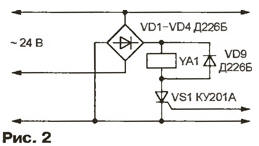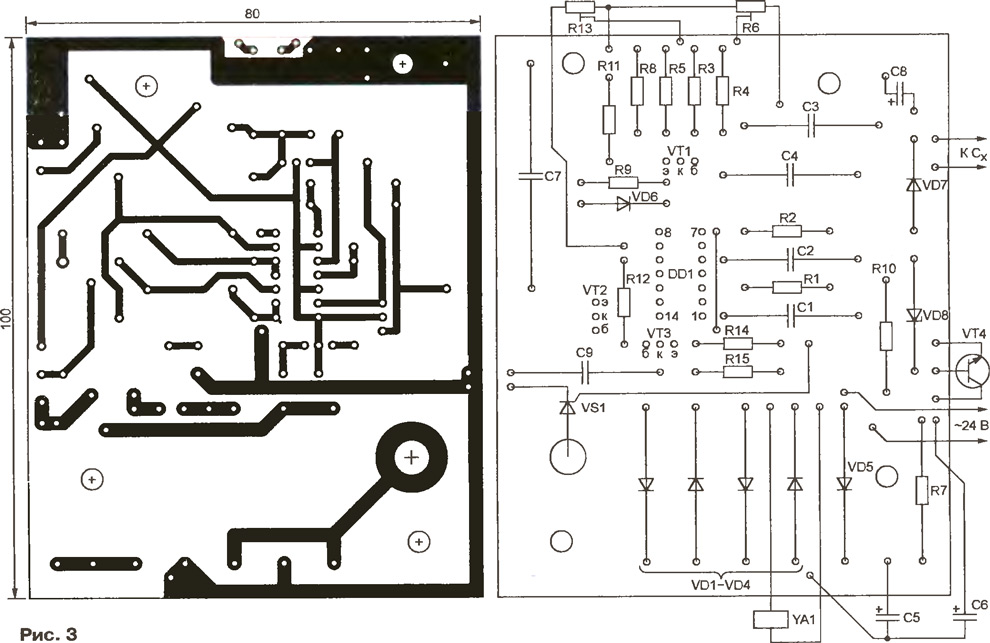In the artificial cultivation of mushrooms in the greenhouse you want to support specific humidity of the substrate with mycelium, pouring it in small portions water and prevent waterlogging. Start watering when dry drops of water, remaining from the previous one. Technically it is possible to implement with by means of the capacitive relay responsive to the presence of droplets. Relay controls solenoid valve, opening the access of water in the irrigation system.
Capacitive relay should permit the flow of water at a lower humidity of the substrate, and deny - when more, i.e. to have hysteresis. Otherwise, watering too often, it is possible the water valve bounce, its incomplete the opening and closing. Hysteresis is easy to provide using electromagnetic relay, the tripping currents and release which are not equal. But high humidity mechanical contacts unreliable, and therefore preferable to operate the valve by means of the electronic key, and the hysteresis to provide, for example, due to the positive feedback.
The prototype of the capacitive relay, the circuit of which is shown in Fig. 1 were design I. Nechayev ("Radio", 1988, № 1, p. 33). The device described there on chip of CMOS structure with a resistor up to 6 MW was completely inefficient in terms of the characteristic of the greenhouse environment with increased humidity. In the present embodiment installed the chip patterns 155 TTL, the resistance of the resistor is greatly reduced. Provides manual adjustment actuation level and the width of the region of hysteresis. For reasons electrical relays are powered 24 volt AC, permitted for use in greenhouses.

(click to enlarge)
Humidity sensor mycelium serves four twisted into a bundle of wires in polyethylene insulation diameter 0.5 mm (copper). Suitable wires can extract from telephone cable CCI. Wiring harness section with a length of 4.5 m is wound on a frame size 180x160 mm of insulating material. One end of the segment isolated - coated with molten bitumen and wrapped with plastic wrap. Wire on connect the other end in pairs and connected to a capacitive relay installed nearby, but above the zone of action of the irrigation nozzles. As dielectric water permeability is very high, drops, settling on the wires of the sensor increases capacity between approximately 300 to 600 pF.
On the elements DD1.1 and DD1.2 assembled symmetrical multivibrator, which, as the audit showed, works more reliably asymmetric. Multivibrator generates rectangular pulses with a frequency of 50 kHz. To the exit of the element DD1.2 connected a differentiating circuit R5C4. Since the capacitor C4 forms capacity sensor CX of the capacitive voltage divider, the amplitude differentiated pulses at the base of the transistor VT1 depends on the number moisture deposited on the sensor wires. The capacitor C3 separation.
The emitter of the transistor VT1 is allocated only the peaks of the positive pulses polarity and of approximately triangular form. The threshold depends on the cutoff bias voltage supplied to the base of transistor VT1 through resistors R3 and R4. With the decrease in threshold with increasing amplitude and pulse duration. Similar the effect is observed when decreasing the capacitance of the sensor Sh. At the exit of the element DD1.3 - rectangular pulses of a logic low level, the duration of which depends from the position of the engine tuning resistor R6, humidity sensor and magnitude the feedback voltage supplied through the resistor R3.
If the level is low at the exit of the element DD1.3, the capacitor C7 is discharged through the diode VD6, with a high slowly charged through resistor R9. The capacitance of the capacitor C7 is chosen large enough to ensure that he did not have time to fully recharge or discharged. The average value of the voltage is approximately inversely proportional to the pulse duration. If the voltage on the capacitor C7 (with into account the voltage drop on the section of the base and the emitter of the transistor VT2) below the threshold switching element DD1.4, the voltage logic high output this element is supplied through the resistor R12, smithery repeater on the VT3 transistor and a resistor R14 to the control electrode of SCR VS1. SCR included in the diagonal of the diode bridge VD1-VD4, opens and closes the supply circuit of the electromagnetic valve YA1. Watering is allowed.
Part of the output voltage of the element DD1.4, remove the shift trim resistor R13 serves as a positive feedback signal, creating the required hysteresis.
As mushroom substrate wetting sensor capacitance CX increases. This leads to the decrease of the pulse amplitude on the base of the transistor VT1 and the voltage increase on the capacitor C7.
When a sufficient humidity high voltage level at the output element DD1.4 is replaced by a low, SCR VS1 is closed and the valve W terminates the access of water into the irrigation system.
The variant is designed for valve YA1, controlled variables voltage. If the valve or other control device operates from a DC power circuit capacitive relay can be collected according to the scheme depicted in Fig. 2.

The diode VD5, capacitors C5, C6 and resistor R7 assembled half-wave a rectifier. Stabilizer transistor VT4 provides at its output 5 V to power the chip DD1.
Printed circuit Board relays and capacitive arrangement of parts therein shown in Fig. 3. The device uses resistors MM capacitors BM and MBM, oxide capacitors K50-6, and C5 and C6 are set out fees. The transistor VT4 is provided with a heat sink area of 20 cm2. For small (<3 watts) power irrigation valve in the outlet heat from the thyristor VS1 is not necessary.

(click to enlarge)
Establishing the relay should pick up capacitor C4, the capacity of which must be approximately one and a half times more capacity sensor dry. The threshold adjust trimpot resistor R6, and hysteresis (the difference threshold actuation and release) - R13. If optimum performance is achieved only when installing these resistors in an extreme situation, you should change the values of resistors R3 and R4.
Author: Y. Egorov, Moscow






